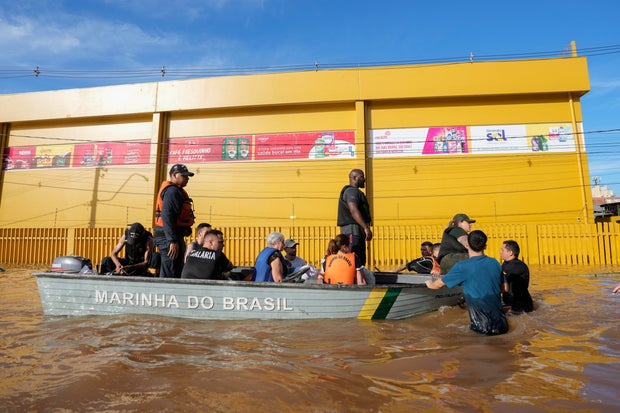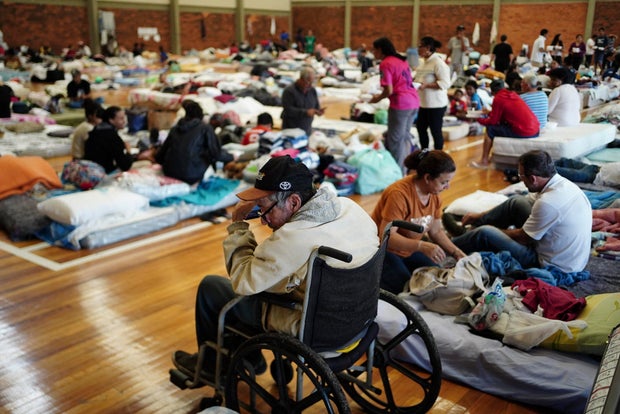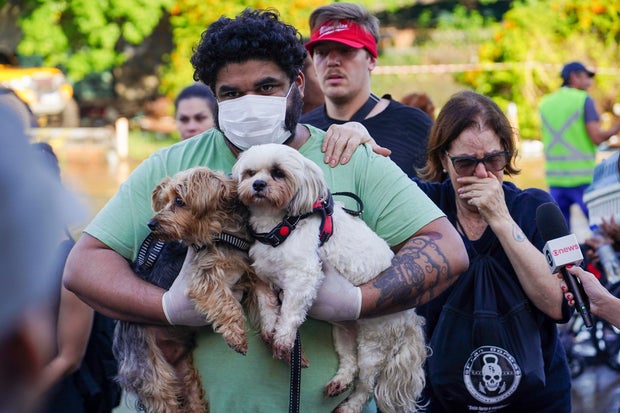The number of deaths from devastating floods that ravaged southern Brazil for days reached 100 on Wednesday, authorities said, as searches continued for dozens of people still missing.
Almost 400 municipalities were affected by worst natural calamity which hit the state of Rio Grande do Sul, with hundreds injured and 160,000 forced to leave their homes.
Many do not have access to clean water or electricity – or even the means to call for help, as telephone and Internet services are unavailable in many places.
On Tuesday, the state governor, Eduardo Leite, warned that the number of human casualties would likely increase as “the emergency continues to develop” in the state capital, Porto Alegre, and other cities and towns. Authorities have urged people not to return to affected areas due to possible landslides and health risks.
André Penner/AP
“Contaminated water can transmit diseases,” warned Civil Defense spokeswoman Sabrina Ribas this Wednesday.
Around 15,000 soldiers, firefighters, police officers and volunteers worked across the state, many on boats and even jet skis, to rescue those trapped and transport aid.
Many people are reluctant to leave their homes for the safety of shelters amid reports of looting of abandoned properties.
The National Confederation of Municipalities said nearly 100,000 homes were damaged or destroyed by unprecedented rain and flooding in the state, with losses estimated at more than $900 million.
Porto Alegre is home to around 1.4 million people and the largest metropolitan area has more than double that number.
The Guaíba River, which flows through Porto Alegre, has reached historic levels and five dams are at risk of collapse.
Carlos Macedo/AP
There were queues at public taps and wells as authorities warned that the most urgent need for people stranded by impassable roads, collapsed bridges and flooded homes was drinking water.
Only two of Porto Alegre’s six water treatment plants were working, the mayor’s office said Tuesday, and hospitals and shelters were being supplied by tanker trucks.
Helicopters delivered water and food to communities most in need, while work continued to restore road access.
The Brazilian Navy would send its ship “Atlântico” – the largest in Latin America – to Rio Grande do Sul on Wednesday with two mobile water treatment stations.
President Luiz Inácio Lula da Silva promised that “there will be no shortage of resources to meet the needs of Rio Grande do Sul”.
In Gasometer, a part of Porto Alegre popular with tourists, water continued to rise on Wednesday, complicating rescue efforts.
André Penner/AP
“You can only cross on foot or by boat. There is no other way,” Luan Pas, a 30-year-old resident, told AFP, close to a street turned into a stagnant and smelly river.
Operations at the port of Porto Alegre were suspended and its international airport closed indefinitely.
The Air Force said the military base outside the city would receive commercial flights carrying aid and passengers.
In a rare dry place in the historic center of Porto Alegre, dozens of people gathered around a generator rented by a pharmacy to charge their cell phones.
“This is a parallel universe,” said one of them, university professor Daniela da Silva, 30 years old.
The Inmet meteorological institute warned of more storms with rain and strong winds in the south of the state and showers over the weekend in the Porto Alegre region.
Carlos Macedo/AP
The World Meteorological Organization, in a report on Wednesday, said Latin America and the Caribbean recorded its hottest year on record in 2023 — “a year of record climate risks” for the region due to climate change and El Niño weather phenomenon.
Many towns and cities in Brazil, he said, were hit by “exceptional rains” that caused displacement and major upheavals.
Because of Climate ChangeExtreme or rare events “are becoming more frequent and more extreme,” José Marengo, research coordinator at Brazil’s National Center for Monitoring Natural Disasters (Cemaden), told AFP.
According to the MetSul meteorological agency, the floods “changed the map of the metropolitan region” of Porto Alegre.


























